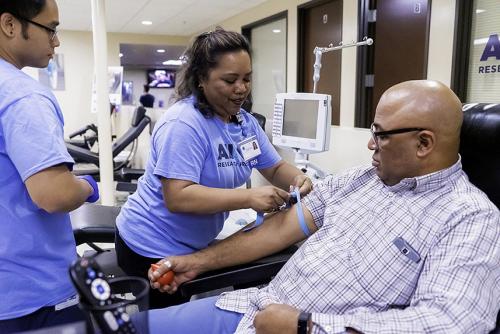Leaders of NIH’s All of Us Research Program recap progress and next steps
Strong progress has been made in efforts to advance precision medicine
The All of Us Research Program at the National Institutes of Health has made strong progress in its efforts to advance precision medicine, according to program leadership in a forthcoming paper.

Two All of Us team members begin the process to collect a blood sample from a participant.
With information provided by volunteers across the United States, All of Us is developing a robust data platform to support a wide range of health studies. The program aims to include data from 1 million or more people from diverse communities. As of July 2019, more than 230,000 people have enrolled, including 175,000 participants who have completed the core protocol. Of those, 80% are from groups that have been historically underrepresented in biomedical research. Participants contribute information in a variety of ways, including surveys; electronic health records (EHR); physical measurements; blood, urine, and saliva samples; and Fitbit devices. In the future, the program will add new surveys and linkages to other data sets and digital health technologies, and begin genotyping and whole-genome sequencing participants’ biological samples. Data will be broadly accessible to approved researchers, and participants will receive information back about themselves.
In May 2019, with enrollment ongoing, the program released initial summary data. Now, the All of Us team is planning demonstration projects to assess the usefulness and validity of the data set, in preparation for the launch of the Researcher Workbench — the secure platform where researchers will be able to conduct analyses.
The program’s ongoing success will rely on several factors, according to the authors. The program must continue to enroll participants from across the country, including those in rural and other underserved areas. The program needs to ensure that participants, once enrolled, derive value, remain engaged, and retain trust in the program such that they continue to share data long term. Additionally, the program must continue to protect from cyberattacks, protect participant privacy, and harmonize data from different EHR systems. Work is underway on all these fronts.
The authors anticipate that the program’s value will become even more rich as it matures, enabling new discoveries over time. A goal of the study is to improve population health through the identification of risk factors and biomarkers (including environmental exposures, habits, and social determinants) to allow more efficient and accurate diagnosis and screening, better understanding of diverse populations, more rational use of existing therapeutics, and the development of new treatments.
Source: U.S. National Institutes of Health
- 225 reads
Human Rights
Ringing FOWPAL’s Peace Bell for the World:Nobel Peace Prize Laureates’ Visions and Actions

Protecting the World’s Cultural Diversity for a Sustainable Future

The Peace Bell Resonates at the 27th Eurasian Economic Summit

Declaration of World Day of the Power of Hope Endorsed by People in 158 Nations

Puppet Show I International Friendship Day 2020

